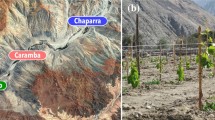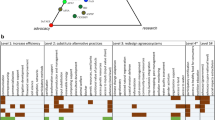Abstract
The intrinsic dynamics andinnovative potential of the rural poor in Chinacan be illustrated by the phenomena of farmerinnovation circles (FIC) in north Shaanxi.These are informal networks used by farmers tocollaborate on technology learning andagricultural production. Though not limited tospecific geographic locations, these circlesare particularly important in the marginalareas of rural China where the complexity ofthe geographic environment, the diversity offarmer demands, and the inefficiency of formalagricultural extension networks impede thespread of new agricultural technologies. Socialconnectedness in the form of householdcommunication networks, technology learninggroups, and inter-village links aids people's collective capacity to work together. In thestudy of 50 villages in this remote region, itwas found that households with more connectionswere more likely to adopt a range of newtechnologies (ploughs, varieties, inputs,orchards, afforestation, grazing landrehabilitation), and so had higher income. Adetailed case study shows how collective actioncan lead to environmental improvements thatfurther increase incomes. It is concluded thatif there is to be sustainable development inthe marginal areas of China, then there willclearly need to be closer communication andinteraction between agricultural professionalsand rural communities.
Similar content being viewed by others
References
Carney, D. (1998). Sustainable Rural Livelihoods: What Contribution Can We Make? London: Department for International Development (DFID).
Cernea, M. M. (1987). “Farmer organizations and institution building for sustainable development.” Regional Development Dialogue 8: 1-24.
Chambers, R., A. Pacey, and L. A. Thrupp (eds.) (1989). Farmer First: Farmer Innovation and Agricultural Research. London: IT Publications.
Chang, X. Q. and S. Feuchtwang (1996). Social Support in Rural China (1979-91): A Statistical Report on Ten Villages. London: China Research Unit, City University.
Chinese Academy of Sciences (CAS) (1991). A Study on Rational Distribution and Harmony Development of Agriculture, Forest and Animal Breeding in the Loess Plateau. Survey Term for the Loess Plateau Resources and Environment. Beijing: Kexie Press [in Chinese].
Coleman, J. (1988). “Social capital and the creation of human capital.” American Journal of Sociology 94 (supplement): 95-120.
Coleman, J. (1990). Foundations of Social Theory. Cambridge, Massachusetts: Harvard University Press.
Delman, J. (1991). Agricultural Extension in Renshou County, China: A Case-study of Bureaucratic Intervention for Agricultural Innovation and Change. Aarhus, Denmark: Institute of East Asian Studies.
Fan, S. and P. Pardey (1997). “Research, productivity, and output growth in Chinese agriculture.” Journal of Development Economics 53: 115-137.
Fine, B. (1998). The World Bank and Social Capital: A Critical Skinning. Mimeo. London: SOAS.
Flora, C. B. and J. L. Flora (1993). “Entrepreneurial social infrastructure: A necessary ingredient.” The Annals of the American Academy of Political and Social Science 529: 48-55.
Flora, J. L. (1998). “Social capital and communities of place.” Rural Sociology 63(4): 481-506.
Jalan, J. and M. Ravallion (1997). Geographic Poverty Traps? A Micro Model of Consumption Growing in Rural China.Washington, DC: World Bank.
Khan, A. R. (1998). Poverty in China in the Period of Globalization: New Evidence on Trend and Pattern. Discussion Paper 22, Issues in Development. Geneva: International Labor Organization.
Knight, J. (1992). Institutions and Social Conflict. Cambridge, UK: Cambridge University Press.
Krishna, A. (2002). Active Social Capital. Tracing the Roots of Development and Democracy. New York: Columbia University Press.
Natural Bureau of Statistics of China (NBS) (2000). Statistical Tables of Regional Development. Beijing: NBS [in Chinese].
Piazza, A. and E. H. Liang (1998). “Reducing absolute poverty in China: Current status and issues.” Journal of International Affairs 52(1): 253-273.
Pretty, J. N. (1995). “Participatory learning for sustainable agriculture.” World Development 23(8): 1247-1263.
Pretty, J. N. (2002). Agri-Culture: Reconnecting People, Land and Nature. London: Earthscan.
Pretty, J. and H. Ward (2001). “Social capital and the environment.” World Development 29(2): 209-227.
Putnam, R. D. (2001). “Social capital measurement and consequences.” Canadian Journal of Policy Research 2(1): 41-51.
Putnam, R. D., R. Leonardi, and R. Y. Nanetti (1993). Making Democracy Work: Civic Traditions in Modern Italy. Princeton, New Jersey: Princeton University Press.
Rahman, A. and C. Riskin (1998). “Income and inequality in China: Composition, distribution and growth of household income, 1988 to 1995.” China Quarterly 154: 221-253.
Ravallin, M., S. Chen, and J. Jalan (1996). Dynamics of Rural Poverty in China. Washington, DC: Policy Research Department, World Bank.
Rozelle, S., A. Park, V. Benziger, and C. Q. Ren (1998). “Targeted poverty investments and economic growth in China.” World Development 26(12): 2137-2151.
Röling, N. R. and M. A. Wagemakers (eds.) (1997). Social Learning for Sustainable Agriculture. Cambridge, UK: Cambridge University Press.
Shaanxi's Agricultural Department of Provincial Government (SAD) (1996). Abstract of 1995 Shaanxi Agricultural Statistics.Internal Document in Chinese, unpublished.
Shaanxi's Agricultural Regionalization Office (SARO) (1989).Agricultural Regionalisation of Shaanxi Province. Xian, China: Xian Ditu Press [in Chinese].
Shen, H., L. A. Zhou and S. L. Chen (1992). Peasants in Marginal Areas of China: A Study of Poverty Formation Mechanisms. Beijing: Renming Press [in Chinese].
Shi, Y. C. (2001). “Chinese agricultural development high-tech strategy.” Guang Ming Daily 19 February 2001 [in Chinese].
Uphoff, N. (ed.) (2002). Agroecological Innovations. London: Earthscan.
Woolcock, M. (1998). “Social capital and economic development: Towards a theoretical synthesis and policy framework.” Theory and Society 27: 151-208.
World Bank (2001). China: Overcoming Rural Poverty. Washington, DC: World Bank.
Wu, B. (2003). Sustainable Development in Rural China: Farmer Innovation and Self-organization in Marginal Areas. London: RoutledgeCurzon.
Wu, B., M. Parnwell, and P. Bradley (2002). “Farmer self-organizing innovation in the marginal areas of China: A study of farmer communication networks in Zhidan, Loess Plateau.” Journal of Rural Cooperation 30(1): 43-63.
Yang, M. (2003). “China's rural electrification and poverty reduction.” Energy Policy 31(3): 283-295.
Yao, J. F., L. M. Yang, Y. Fang, P. Z. Guo, C. X. Wu, J. Y. Ren, and H. Xu (1996). China's NGOs: A Study of Rural Specialized Technique Associations. Beijing: Nongye Keji Press [in Chinese].
Yao, S. J. (2000). “Economic development and poverty reduction in China over 20 years of reforms.” Economic Development and Cultural Change 48(4): 447-474.
Yonggong, L. (1998). “Institutional and policy reform of rural extension in China during the transition towards a market economy.” Training for Agricultural and Rural Development 1997-1998 issue. Rome: FAO.
Zhao, J. C. (2000). “Experience learning from international aid projects in China: A case study of Germany government funded forestry project.” In Z. Li (ed.), China's Sustainable Rural Development in the 21st Century (pp. 259-274). Beijing: Shihui Kexiu Wenxian [in Chinese].
Zhidan Planning and Statistical Office (ZPSO) (1996). Statistical Yearbook of Zhidan in 1995. Internal document in Chinese, unpublished.
Zhu, L. and Z. Y. Jiang (1996). Public Works and Poverty Alleviation in Rural China. Commack, New York: Nova Science Publishers.
Zhuge, R. and C. Tisdell (1999). “Sustainability issues and socio-economic change in the Jingpo communities of China.” International Journal of Social Economics 26(1): 21-45.
Author information
Authors and Affiliations
Corresponding author
Rights and permissions
About this article
Cite this article
Wu, B., Pretty, J. Social connectedness in marginal rural China: The case of farmer innovation circles in Zhidan, north Shaanxi. Agriculture and Human Values 21, 81–92 (2004). https://doi.org/10.1023/B:AHUM.0000014025.47576.72
Issue Date:
DOI: https://doi.org/10.1023/B:AHUM.0000014025.47576.72




